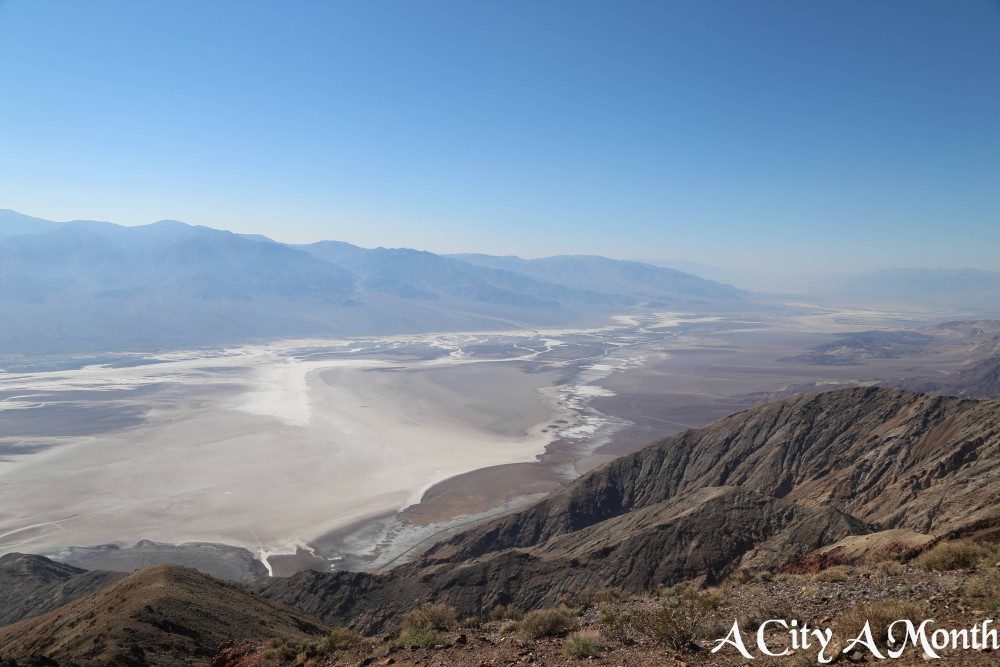For thousands of years, Death Valley has enticed adventurers hoping to suss out secrets, or perhaps plunder riches. But more recently, it is the traveler who comes and slips into an outdoor tapestry that guarantees this out of the way destination is a trip you’ll remember for the rest of your life.
Aside from its sheer size as the largest national park in the continental U.S. and temperatures hot enough to cook eggs in the summer Death Valley is also the lowest spot in the contiguous U.S. at 282 feet below sea level.

The words “Sea Level” at the top center are about 282 below the wooden sign just to the right of our Prius.
And though it appears devoid of life, the landscape is replete with flora and fauna including an impressive list of predators and carnivores, desert bighorn sheep, a cohort of reptiles and birds, and wildflowers that blanket hillsides in vivid colors after brief spring rains.

Artist’s Palette is an unusual deposit of clays infused with various iron salts, mica and manganese.
The Timbisha Shoshone Tribe has called the Death Valley area home for at least 1,000 years and rock art indicates human habitation as far back as 9,000 years. Their knowledge of the land, locations of water and seasonal changes enabled them to live off the land.
Gold fever lured the first non-native Americans through Death Valley, in hopes of a shortcut to the California gold fields discovered in 1849. After one group nearly perished, a rescued survivor turned and reportedly uttered, “Goodbye, Death Valley.” The name stuck.

Battling searing heat, relentless thirst and bone-cutting sand, men of hardiness and grit loaded wagons with seven-foot high wheels full of borax then hitched on a team of 20 mules to haul it out.

Only the most sturdy construction would endure in Death Valley. To survive the journey, the tank on the left was filled with water for both men and mules.

Death Valley’s has the lowest elevation in the U.S. and Badwater Basin describes this places on a number of levels.
But fortune seekers persisted and over the years Death Valley has yielded gold, silver, borax, talc, zinc, lead, cinnabar, mercury, manganese, tungsten and other minerals. The stark beauty of the landscape has served as the backdrop for movies, television, commercials and advertising.
First established as a national monument in 1933 and then a national park in 1994, Death Valley can easily take a week or more to enjoy just a few of the top attractions. In 2014 the National Park Service estimated 1,101,312 people visited Death Valley.
Among the more popular spots within the 3.3 million acres are Dante’s View at 5,000 feet above the valley floor, Zabriskie Point, Badwater Basin at 282 below sea level, Artist’s Palette is a showcase of color,
The Racetrack is where giant boulders glide across a dried mud bed, Harmony Borax Works was a cauldron where sturdy men clawed borax from unforgiving ground, Scotty’s Castle is a mansion in the middle of nowhere, Titus Canyon and other routes offer incredible hiking,
and any number of the gigantic sand dunes in the park offer hours of enjoyment.
The implications of the park’s name are real, so visitors must plan ahead, always be prepared, know temperature and weather conditions, and have plenty of water and sunscreen. Temperatures can easily reach 120 degrees Fahrenheit or more during summer months.
If you are an outdoor adventure type, maybe a room service and linen napkin traveler, or a family looking for one of life’s great memories, you can’t say you’ve really lived until you’ve been to Death Valley.
For more information about Death Valley, visit www.nps.gov/deva/index.htm, www.deathvalley.com, or www.furnacecreekresort.com.








